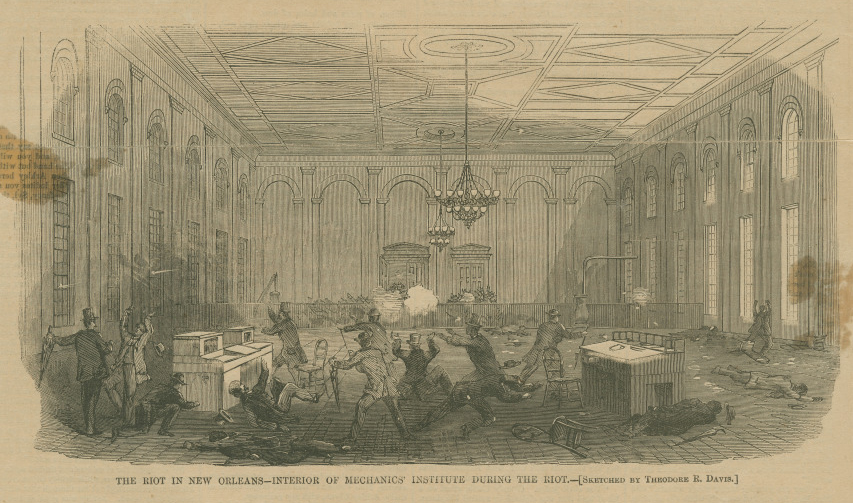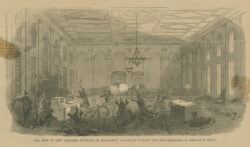Mechanics’ Institute Massacre of 1866
Following the Civil War, an attempt to amend the state’s constitution to grant Black men the vote provoked a deadly reaction from white supremacists, sparking national outrage and significant reforms.

The Historic New Orleans Collection
The Mechanics Institute Massacre as featured in Harper's Weekly, 1866
The struggle for African Americans’ political rights during the Reconstruction period, as slavery ended in the wake of the Civil War, met with several incidents of extreme racist violence. One of the most egregious occurred in New Orleans on July 30, 1866, at the Mechanics’ Institute, a government building located where the Roosevelt Hotel now stands. Black Louisianans had fought courageously for the Union, but former Confederates quickly returned to power. An attempt to amend the state’s constitution to grant the vote to Black men provoked a deadly reaction, with the complicity of some city authorities. Dismissed as a “riot” by white supremacists, the massacre sparked national outrage and spurred significant reforms.
Background: The Movement for Black Suffrage
Following the capture of New Orleans and surrounding parishes by federal forces in April 1862, Louisiana became a test case for readmission into the Union, even as the Civil War raged on. Divisions between white Unionist factions arose over the status of Black Louisianans, with conservatives trying to limit their rights and radicals hoping to promote political equality. French-speaking free people of color launched a campaign for voting rights, using their recently founded newspaper L’Union and personally lobbying President Abraham Lincoln.
The new “Free State” constitution, adopted in July 1864, abolished slavery but did not address Black suffrage. Before long the problems with this approach grew apparent. After the war’s end and Lincoln’s assassination in April 1865, former Confederates took control of the state legislature and New Orleans’s municipal administration. The harshly racist laws comprising the Black Code of 1865 sought to restore slavery in all but name. After the passage of the national Civil Rights Act of 1866, progressives in the newly formed Republican Party of Louisiana felt both cornered and somewhat emboldened. Realizing the need to mobilize the Black vote, Governor James Madison Wells reopened the constitutional convention of 1864 in order to adopt universal male suffrage.
The Unfolding of “An Absolute Massacre”
The decision to reconvene the assembly generated controversy. Not only was the reconvening based on a technicality, thus casting doubt on its legality, but many also foresaw a violent outcome given the white supremacists’ hostility. Though some authorities like Mayor John T. Monroe wanted to forbid the meeting altogether, preparations continued. Meanwhile, the Creole activists at the New Orleans Tribune, the successor to L’Union, pressed for recognition of the convention. On Friday, July 27, 1866, supporters organized a rally drawing crowds of Black residents. The militant tone of the speeches alarmed opponents.
The following Monday at noon, twenty-seven delegates gathered inside the Mechanics’ Institute under the supervision of Judge Rufus K. Howell, president of the convention. Outside, a parade of Black veterans drew the jeers and belligerence of some white onlookers. Initially, neither police nor soldiers were present, and the region’s military governor, Major General Philip Sheridan, had left for Texas. Tensions in the street turned violent. When city police and auxiliary officers arrived, many of them aided in the mob’s attacks, hurling racist insults as they assaulted, chased down, and murdered supporters of the convention as well as African American bystanders. Moreover, several policemen turned their guns on the meeting itself, shooting through the windows before entering the building. The convention’s chaplain, Reverend Jotham W. Horton, a native of Boston, received a fatal gunshot wound while waiving a white handkerchief in surrender. The violence persisted though the afternoon, leaving numerous bodies of the wounded and dead in the streets. At six o’clock, the military arrived to declare martial law.
The massacre claimed almost fifty victims, Black and white. Though no friend of the convention, General Sheridan summarized his assessment in a telegraph to Ulysses S. Grant: “The more information I obtain of the affair of the 30th in this City, the more revolting it becomes. It was no riot, it was an absolute massacre by the police […].”
Newspaper Coverage of the Massacre
Even while the wounded lay in the hospital and families began to mourn their lost loved ones, the struggle to control the interpretation of events began in the press. Louisiana’s white supremacist newspapers placed the blame squarely on the advocates of equal voting rights. “The riot was commenced in every instance by negroes, spurred on by white men,” argued the New Orleans Times, “and it is highly creditable to the police of the city that they succeeded in quelling it without military aid.” The New Orleans Tribune painted a very different picture. A two-part reported entitled “Pages for a Narrative of the New Orleans Massacre,” soon republished in papers across the North, claimed that municipal authorities had organized the attack. In late August the Tribune printed an eyewitness account from Octave Breaux, a Black veteran who had overheard plans to disrupt the convention through violence.
These issues came to the fore during official investigations, culminating in a congressional report released several months later. Still today the testimonies offer a rich source for historians who continue to debate the massacre’s causes, with some attributing it to an explosion of racist rage, some to concerted action by the authorities, and others to economic rivalry between the racial groups.
Impact and Legacy
One year after the massacre, civil rights activists held a commemorative ceremony at the Mechanics’ Institute. Attendees sat before an altar draped with a banner that read, “In Memory of the Victims of the 30th of July,” while Creole composer Samuel Snaër played the organ and led the choir. Orators paid homage to the dead while decrying the crimes of “the Rebels.”
By this time the activists’ message had reached the halls of power in Washington. Along with events elsewhere that discredited the weak approach of Lincoln’s successor, President Andrew Johnson, the massacre helped to usher in Radical Reconstruction. Congressional action offered stronger support and robust guarantees of the rights of African Americans whose citizenship became enshrined in the Fourteenth Amendment. Louisiana’s Constitution of 1868 would outlaw racial discrimination, at least for a time.
